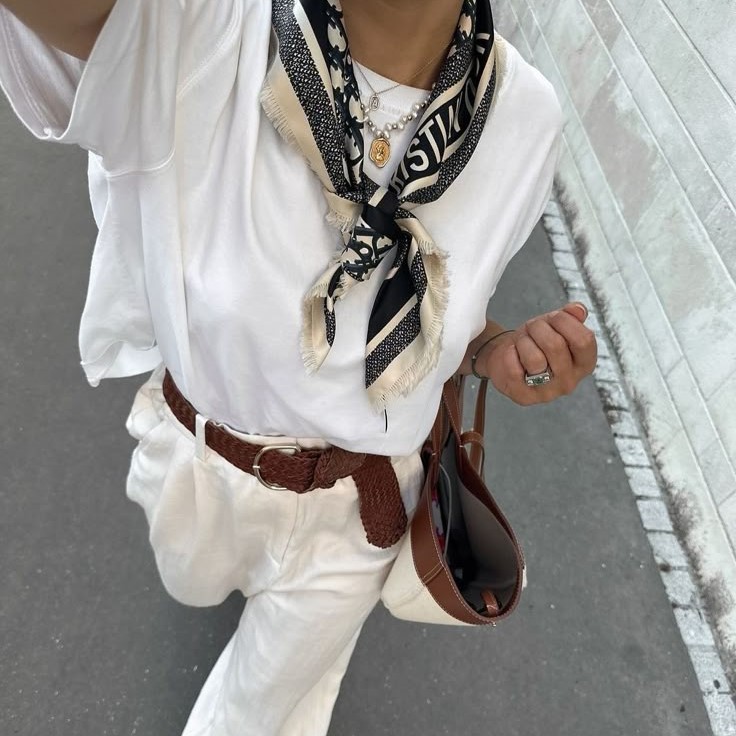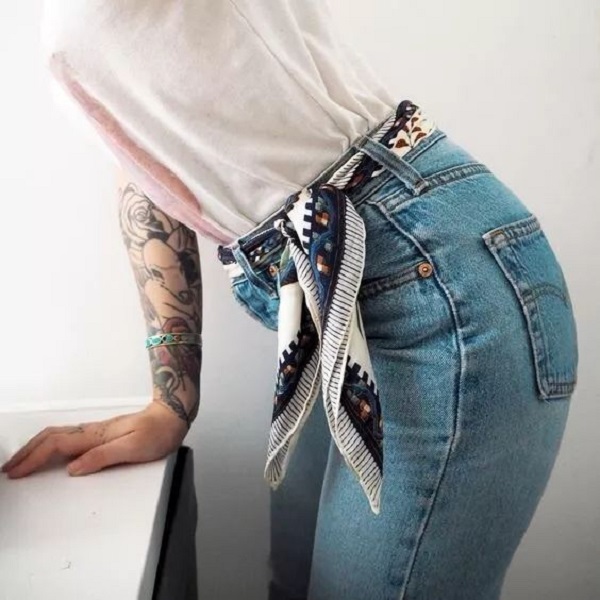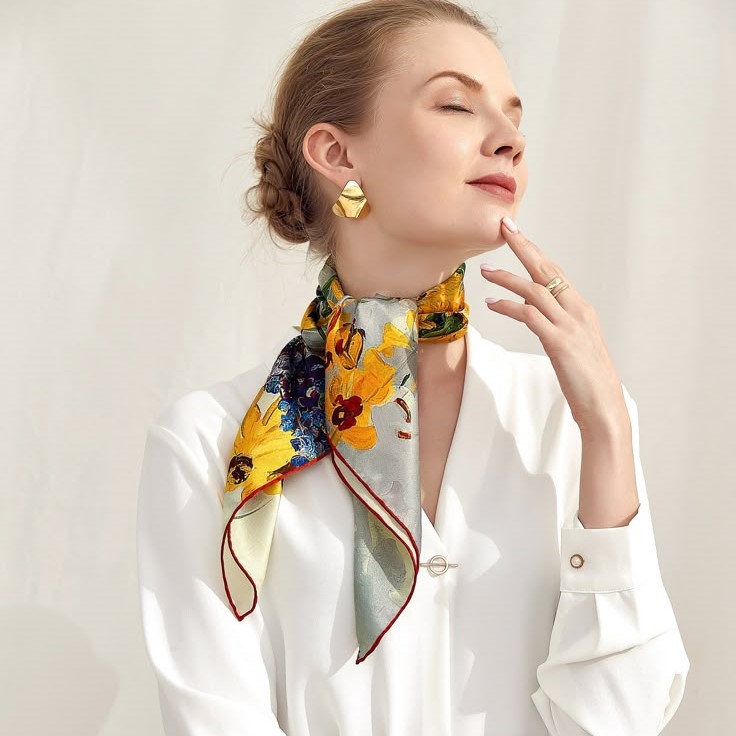Introduction
Silk scarves have long been a staple in fashion, offering a touch of elegance and versatility to any outfit. Whether you’re looking to add a pop of color or a sophisticated accent, knowing how to wear silk scarves can transform your look. In this guide, we will explore various chic and modern ways to incorporate silk scarves into your wardrobe, ensuring you stay on-trend this season. From classic knots to contemporary twists, let’s dive into the world of silk scarf styling.

Understanding the Versatility of Silk Scarves
Silk scarves are incredibly versatile. They come in a variety of colors, patterns, and sizes, making them suitable for different occasions and outfits. A small, square silk scarf can be used as a neckerchief, while a larger, rectangular one can be worn as a shawl. Then, the key to mastering the art of wearing silk scarves lies in understanding their versatility. By experimenting with different styles, you can find the perfect look that complements your personal style.
Different Types of Silk Scarves
- Square Scarves: Ideal for neckerchiefs, headbands, and wrist accessories.
- Rectangular Scarves: Perfect for shawls, belts, and shoulder wraps.
- Oblong Scarves: Great for draping over the shoulders or tying in a loop around the neck.
Color and Pattern Choices
- Neutral Colors: Black, white, beige, and gray are versatile and easy to pair with any outfit.
- Vibrant Patterns: Floral, geometric, and abstract designs add a bold and eye-catching element to your look.
- Monochrome: Solid colors can be elegant and timeless, especially in jewel tones like emerald green, sapphire blue, and ruby red.
Classic Ways to Wear Silk Scarves
The Neck Knot
One of the most classic and timeless ways to wear a silk scarf is by tying it around your neck. The neck knot, also known as the “ascot” or “neck tie,” is a simple yet elegant style. To achieve this look, fold the scarf into a triangle, place it around your neck, and tie the two ends together. This style works well with both casual and formal outfits, adding a touch of sophistication to your look.

The Loop
Another classic way to wear a silk scarf is by creating a loop. Then, fold the scarf in half lengthwise, drape it around your neck, and pull the loose ends through the loop. This style is perfect for colder weather, as it provides warmth and a polished appearance. The loop can be adjusted to create a more relaxed or tighter fit, depending on your preference.
The Shawl
For a more elegant and formal look, you can wear a silk scarf as a shawl. To begin, drape the scarf over your shoulders and let it hang naturally. Furthermore, you can secure it with a brooch or pin for added security and a touch of glamour. Additionally, this style is ideal for evening wear or special occasions.
Modern and Trendy Ways to Wear Silk Scarves
As a Headband
In recent years, wearing a silk scarf as a headband has become increasingly popular. This style not only adds a playful and trendy touch to your outfit but also keeps your hair out of your face. To create this look, fold the scarf into a thin strip, wrap it around your head, and tie it at the nape of your neck. You can adjust the placement of the knot to suit your hairstyle and personal taste.
As a Belt
Another modern and chic way to wear a silk scarf is by using it as a belt. Then, choose a long, rectangular scarf and wrap it around your waist, tying it in a bow or knot at the front or side. This style adds a unique and fashionable element to dresses, skirts, and even high-waisted pants. It’s a great way to cinch in your waist and create a flattering silhouette.
As a Bag Accessory
You can also use a silk scarf to accessorize your handbag. Tie it around the handle of your bag for a pop of color and a touch of elegance. This is a simple and effective way to update an old bag or add a personal touch to a new one.

Styling Tips for Different Occasions
Casual Outfits
For a casual, everyday look, pair a silk scarf with a simple t-shirt and jeans. Opt for a vibrant, patterned scarf to add a pop of color and interest to your outfit. You can also wear a silk scarf as a wrist accessory, tying it loosely around your wrist for a boho-chic vibe.
Office Wear
In a professional setting, a silk scarf can add a touch of elegance and refinement to your outfit. Furthermore, choosing a neutral-colored scarf with a subtle pattern and wearing it with a blazer or tailored dress will enhance your overall appearance. Additionally, a classic neck knot or a simple loop will not only keep your look polished but also maintain a sophisticated style.
Evening Wear
For a night out, a silk scarf can be a glamorous addition to your ensemble. Moreover, consider a luxurious, metallic or jewel-toned scarf and wear it as a shoulder wrap or a shawl. Consequently, this style not only adds a touch of glamour but also enhances the sophistication of cocktail dresses and evening gowns.
Travel Wear
When traveling, a silk scarf can be a versatile and practical accessory. Use it as a neck pillow on long flights, a blanket for extra warmth, or a cover-up when visiting places of worship. Its lightweight and soft texture make it a travel essential.
Choosing the Right Silk Scarf
How to wear silk scarves? When selecting a silk scarf, consider the size, color, and pattern. Smaller, square scarves are ideal for neckerchiefs and headbands, while larger, rectangular ones work well as shawls and belts. Then, for a versatile option, choose a scarf in a neutral color like black, white, or beige, which can be paired with a wide range of outfits. If you prefer a bolder look, opt for a scarf with a vibrant pattern or a bold color.

Quality and Material
- Pure Silk: Offers the best quality and feel, but requires more care.
- Silk Blends: More durable and easier to maintain, but may not have the same luxurious feel.
- Care Labels: Always check the care label to ensure proper maintenance and longevity.
Caring for Your Silk Scarves
To ensure your silk scarves remain in excellent condition, it’s important to care for them properly. Here are some detailed steps and tips for maintaining the beauty and longevity of your silk scarves:
Washing Instructions
Hand Wash with Gentle Detergent:
Always hand wash your silk scarves to prevent damage from the agitation of a washing machine.
Use a gentle, pH-neutral detergent specifically designed for delicate fabrics. Avoid using regular laundry detergents as they can be too harsh on silk.
Use Cold Water:
Fill a basin or sink with cold water. Hot water can cause the silk fibers to shrink and lose their luster.
Gentle Agitation:
Gently swirl the scarf in the water, ensuring that the detergent is evenly distributed. Do not rub or scrub the fabric, as this can cause pilling and damage.
Rinsing:
Rinse the scarf thoroughly with cold water until all the soap is removed. Make sure no residue is left behind, as it can affect the texture and color of the silk.
Avoid Wringing or Twisting:
Never wring or twist a wet silk scarf, as this can cause permanent creases and weaken the fabric. Instead, gently press out the excess water with your hands or use a clean, absorbent towel to blot the moisture away.
Drying:
Lay the scarf flat on a clean, dry towel. Roll the towel up with the scarf inside and gently press to remove any remaining water.
Unroll the towel and lay the scarf flat to air dry. Avoid direct sunlight and heat sources, as they can fade the colors and damage the fabric.
Storage Tips
Avoid Direct Sunlight:
Store your silk scarves in a cool, dark place to prevent fading. UV rays can cause the colors to fade over time, so keep them away from windows and other sources of direct sunlight.
Use Acid-Free Tissue Paper:
Wrap each silk scarf in acid-free tissue paper before storing. Then, this will help protect the fabric from dust, moisture, and potential chemical reactions that can occur with regular paper.
Keep Them Separate:
Store each scarf separately to prevent snags, tangles, and color transfer. You can use individual compartments in a drawer, small boxes, or even hang them on padded hangers if you have the space.

Folding or Rolling:
Fold your scarves neatly or roll them to prevent wrinkles and damage. If folding, make sure to smooth out any creases to avoid permanent marks. If rolling, do so loosely to avoid putting stress on the fabric.
By following these detailed care instructions, you can ensure that your silk scarves remain in excellent condition for years to come.
Conclusion
Knowing how to wear silk scarves can elevate your style and add a touch of elegance to your wardrobe. Whether you prefer classic knots or modern, trendy styles, there are countless ways to incorporate silk scarves into your outfits. By following these tips and experimenting with different looks, you can create a chic and modern appearance that reflects your personal style. So, grab your favorite silk scarf and start exploring the endless possibilities of silk scarf styling.